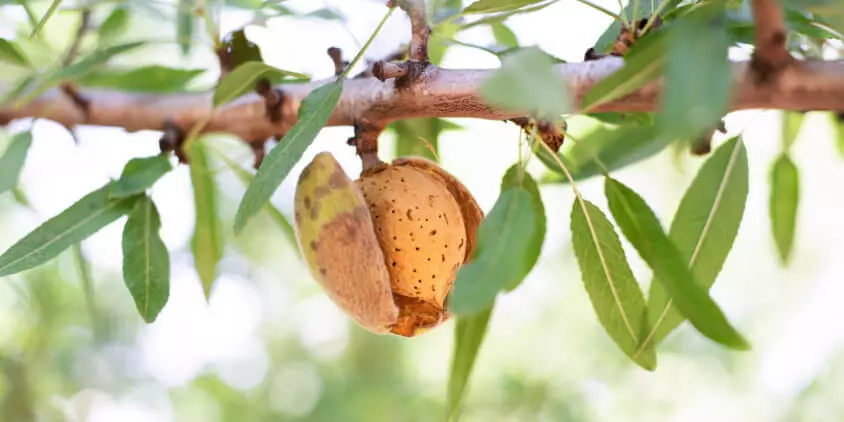
Growing Almonds: Conditions For Crop Success
Growing almonds entails a series of steps with the end goal being a plentiful harvest of this cash crop. Every step of almond growing, from selecting a suitable location for an orchard to harvesting the nuts and post-harvest care for plants, calls for a nuanced blend of traditional knowledge and innovative techniques. Today’s large-scale growers may take advantage of increased efficiency and output thanks to recent developments in precision agricultural technologies. We’ll go through the primary stages of how to grow almond trees and how technological advances are changing the industry for the better, resulting in higher efficiency, resource conservation, and economic rewards.
What Is The Best Climate To Grow Almonds?
Almond trees, which are indigenous to the Middle East, thrive in the mild climate of the Mediterranean. This implies that almonds grow in warm weather and produce best in places with long, hot, dry summers and lots of sunshine. Although the plants grow well in moist winters, they succumb to damage from frost.
The trees only need between 250 and 350 (rarely around 500) hours of cold weather — temperatures below 45°F (7°C) — to induce bud break. This explains why they blossom earlier than other fruit trees and why it is impossible to grow almond trees in the tropics.
These plants do not tolerate cold and rain during their flowering stage, and there are several reasons for this. Cold, rainy almond growing conditions are detrimental to bees’ cross-pollination activities, leading to poorer fruit set and yield. Only 30 minutes of temperatures below 25°F (-4°C) can severely damage flowering plants. Furthermore, wet growing conditions promote the spread of fungal and bacterial infections, which in turn decrease tree productivity.
Almond trees grow best in the Mediterranean countries of Italy, Greece, Spain, Morocco, and Tunisia, although they can also be cultivated successfully in the USA, Australia, Syria, Chile, and Iran. The U.S. states in USDA Plant Hardiness Zones 7–9, such as California, Texas, Florida, Arizona, and Hawaii, are where numerous orchards grow.
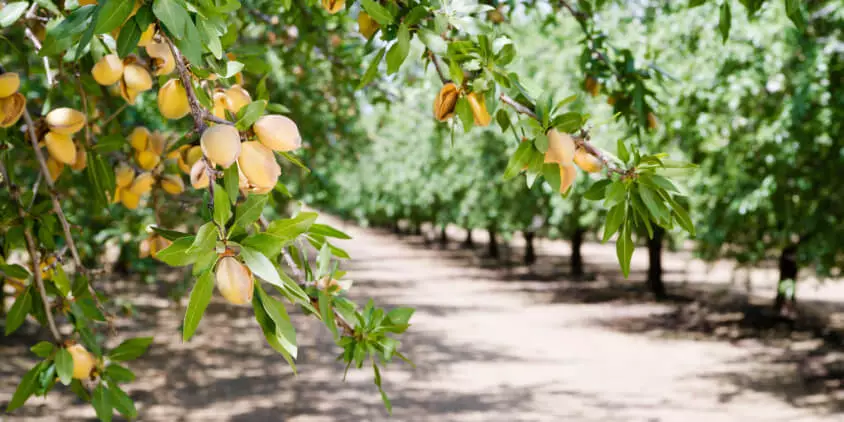
Almond Soil Requirements
There is no best soil for growing almonds, as they are remarkably adaptable and can grow in a diverse range of soil types, spanning from sandy clay to sandy loam. Yet, the trees reach their full potential in soils distinguished by their lightness, fertility, depth, and good drainage capabilities.
While almonds are drought-tolerant and grow and even bear fruit in dry soils for years, the resulting harvest will be significantly lower. Soil aridity is less of an issue near the end of the growing season than it is at the start. It has also been found that trees produce less yield when growing in heavy, poorly-drained soils, which also encourage the growth of plant-killing fungi.
Among almond growing problems is the plant’s extreme sensitivity to salt. Growing trees suffer from dehydration because of soil salinization. Next, dangerous amounts of salt ions begin to build up in the trunk and leaves as the tree’s roots are unable to resist growing salt concentrations, which dramatically decreases the yield. Therefore, in cases of high soil salinity, it is recommended to use amendments to supply a source of calcium for replacing the natrium in the soil and flushing it out of the root zone .
Soil acidity or alkalinity is rarely a limitation for the almond trees’ growth, since they may grow well in areas with a pH between 5.5 and 8.5. However, most seasoned farmers adjust the soil pH to between 6.5 and 8.
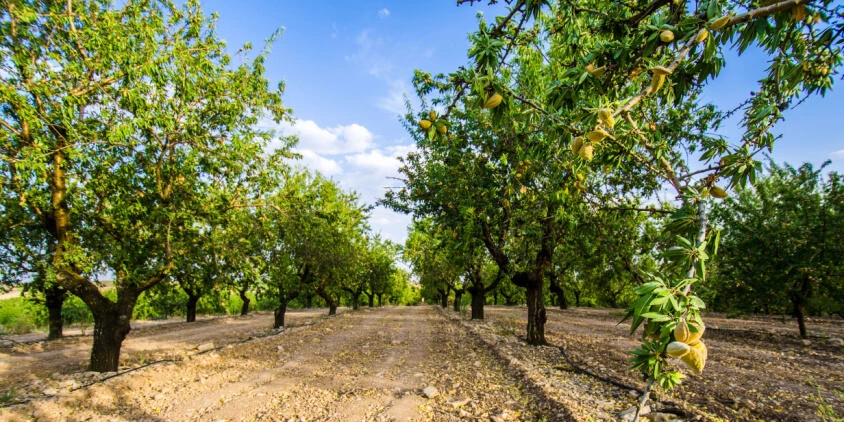
How To Plant Almond Trees
The success of an almond tree planting relies heavily on providing the right growing conditions for the tree to take root. It’s important to give the roots a nice drink of water before putting them in the ground, so they can grow and establish themselves quickly. Almonds, like many other nut trees, are extremely sensitive to having their taproot clipped or shoved into a hole that is too small. To prevent matting, handle the other roots with the same care.
When you fill in the hole, make sure to pack the soil firmly around the roots. Once the hole is filled, give the tree plenty of water. Now, you can also lightly fertilize your plant to enhance its growing conditions.
These trees prefer to grow 15–20 feet (4.6–6 meters) away from one another. Though row-to-row spacings of 20 to 22 feet (6 to 6.7 meters) and tree-to-tree spacings of 12 to 14 feet (3.7 to 4.3 meters) are currently the norm in commercial cultivation, which indicates a shift toward higher almond planting density.
EOSDA Crop Monitoring
Manage your fields with high-resolution satellite images for the most accurate and timely changes detection!
How To Care For Almond Trees
Maintaining the trees’ health during the almond growing season is essential for harvesting a plentiful crop. Primarily, this is achieved through proper care practices like watering, fertilizing, controlling pests and diseases, and pruning.
Regular Watering
Despite their ability to grow in the dry heat of summer, these plants require consistent irrigation. It is essential in growing conditions, where annual rainfall is less than 20 inches (500 mm) . Young growing almond plants’ water usage is high, so water them no fewer than once a week; only if there was heavy rain can you forgo the watering. Keep the soil moist but not soggy, since overwatering might cause fungal diseases.
Almond plants growing in California, for instance, consume an average of 47 acre-inches (4800 m3) of water annually. In contrast, nut producers, as part of the California Almond Sustainability Program, report using an average of 36 acre-inches (3700 m3) of water annually to grow almonds .
Accurate weather data on your site is essential for planning almond irrigation. Our agriculture platform provides precise agrometeorological information, such as historical temperature and precipitation dating back to 1979, as well as reliable 14-day forecasts of wind speed, solar radiation, relative humidity, and other variables. If you want even more specifics on growing conditions, you can connect nearby ground-based weather stations to the platform.
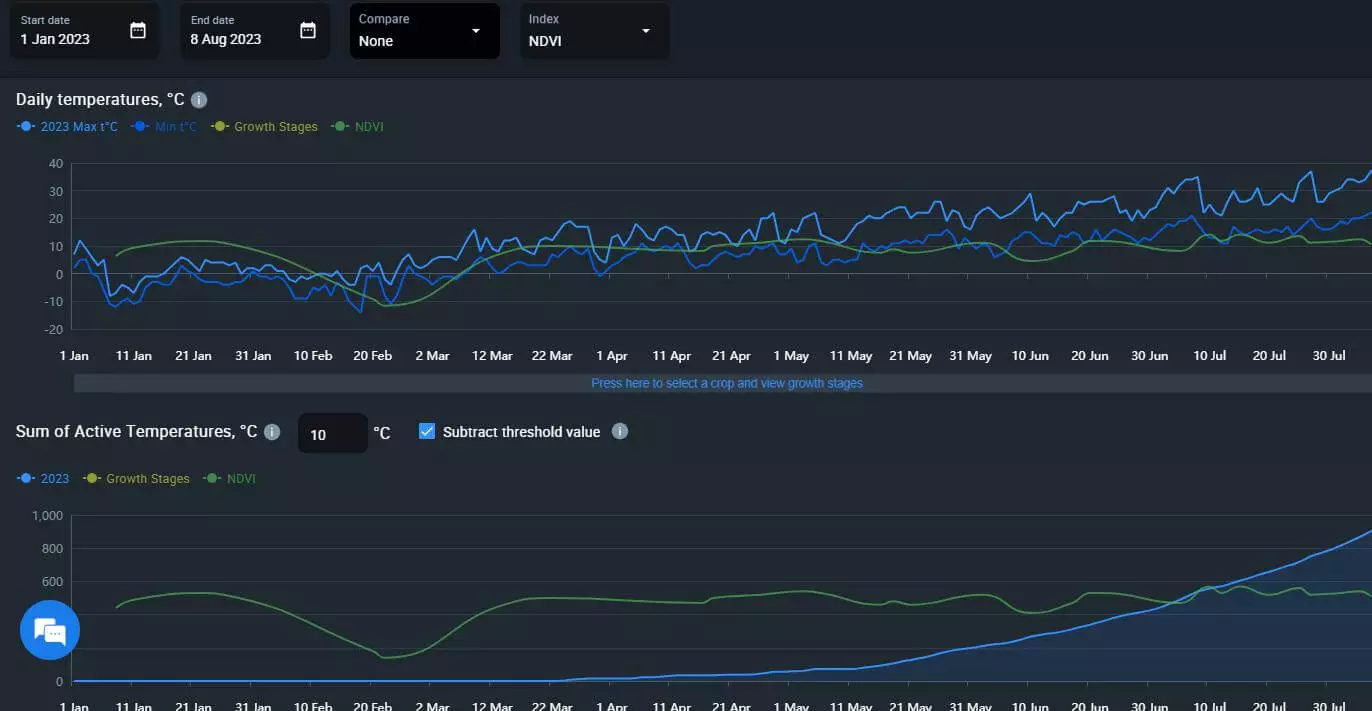

Fertilizing
Start fertilizing your tree in the spring. Small, consistent applications of nitrogen fertilizer to almond trees throughout the growing season are beneficial for young plants, while older plants have a significantly lower fertilizer need. After your tree has become established and begun bearing fruit, you may promote its growing success with a one-time application of 2 pounds (0.9 kilograms) of urea.
To find out where and how much nitrogen (N) to give your growing trees, use the vegetation maps provided by EOSDA Crop Monitoring. Since excessive N-application poses the risk of leaching and polluting soil and water bodies, zoning an orchard according to vegetation indices and then applying variable amounts of nitrogen based on the needs of each zone would help optimize resource allocation and foster a more sustainable agriculture practice.
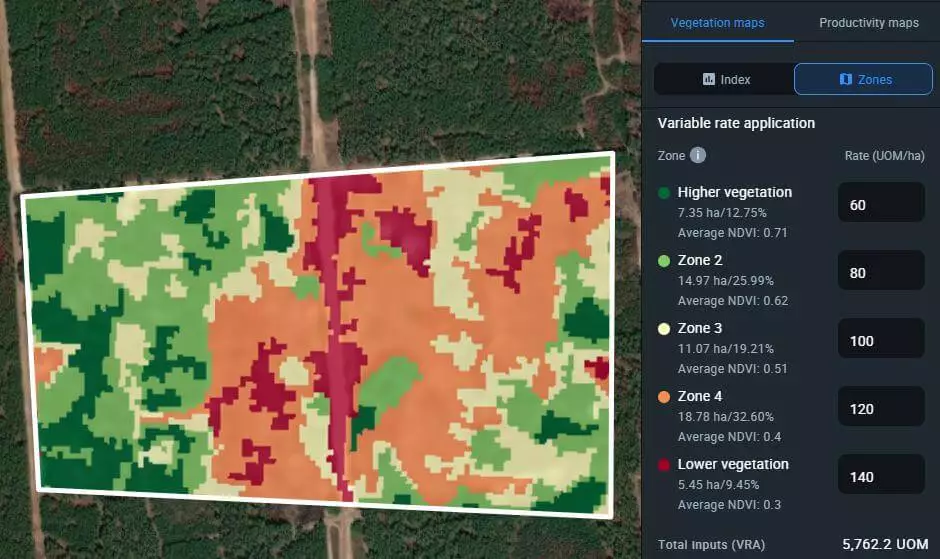
Pest Control
The navel orangeworm is the most prevalent insect that attacks almond trees. This worm overwinters in nuts that were left on the tree after almond harvesting. Taking all the nuts off the tree will deprive these pests of their food source and keep them away from your orchard.
Peach tree borers, another common pest, burrow into the base of the tree’s trunk and cause severe damage. If your almond tree’s growth and development were halted or you found bug droppings at the tree’s base, spraying with a biological pesticide called Bacillus Thuringiensis (Bt) can help combat pests.
Given their susceptibility to numerous pests, almond growing farms require regular inspections to protect both the trees and their fruits. But how can you easily locate a problem on a large plantation? EOSDA Crop Monitoring comes into play here, streamlining pest and disease detection and reducing the cost of it, especially in large-scale growing areas.
The first step is to use vegetation indices on the platform to keep tabs on your plantation and spot any unusual shifts in plant health and density. Then, if pests seem to be present, you can send a scout to this specific growing area to confirm or disprove the cause of concern. Our Scouting app’s easy-to-use interface and the instant availability of scouts’ photo reports to the manager facilitate pest risk analysis on farms of any size.
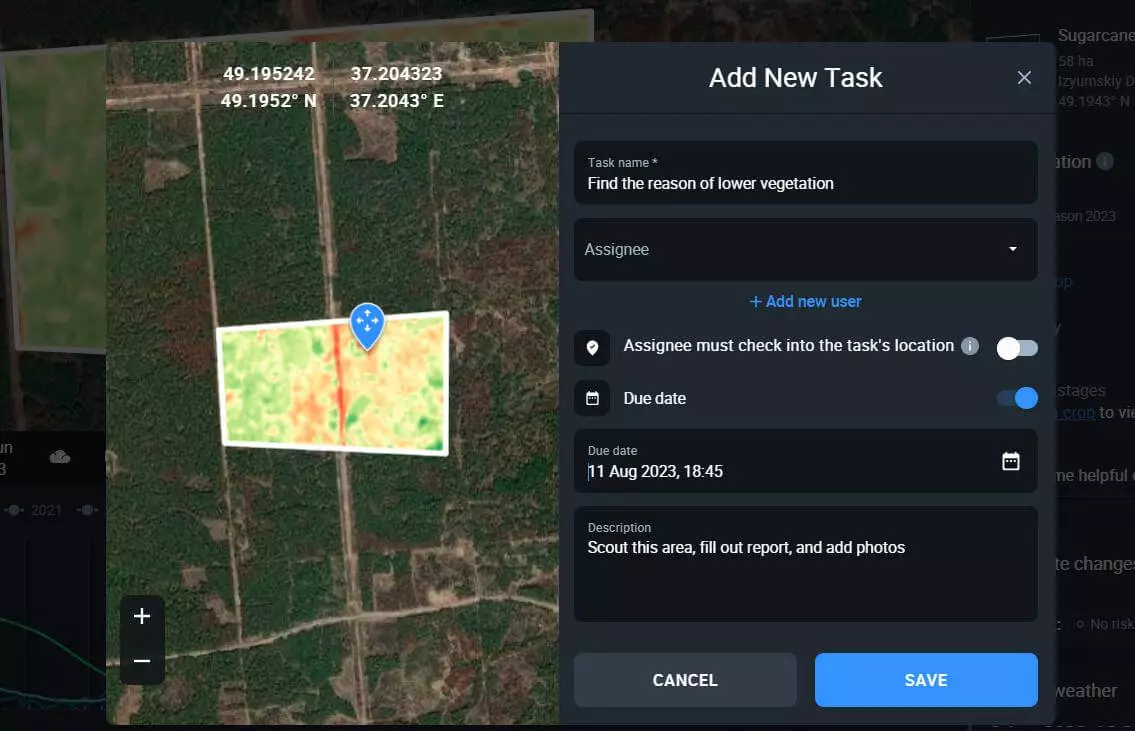
Prevention Of Tree Diseases
The best way to keep tree diseases at bay is to put up a strong defense. Follow these steps to ensure your orchard remains disease-free:
- Water the tree at ground level instead of watering it from above, since the wet environment on the leaves and fruits from overhead watering might encourage the fungi to grow.
- Fungicides help prevent many fungal infections from growing in almond plants. To reduce the likelihood of resistance developing, fungicide chemicals should be rotated.
- Pruning disturbs the cambium layer of trees, so the risk of infection grows. This means you should keep pruning tools clean to prevent the spread of disease.
Pruning
Pruning serves distinct purposes through different tree lifecycle phases, from the early plant growth stages when it helps to form scaffold branches and regulate the tree’s height to the later stages when it is mostly used for canopy management. Pruning promotes young almond trees’ better growth and is essential for shaping them for maximum productivity and nut quality.
When pruning a mature tree, your primary goal should be to preserve its existing shape. Pruning is a great way to revitalize a mature tree and boost its productivity. Each year, prune your older tree so that its canopy is about 20% smaller. For the best results, pruning should be done in the fall, after harvest, and not right before/after it rains.
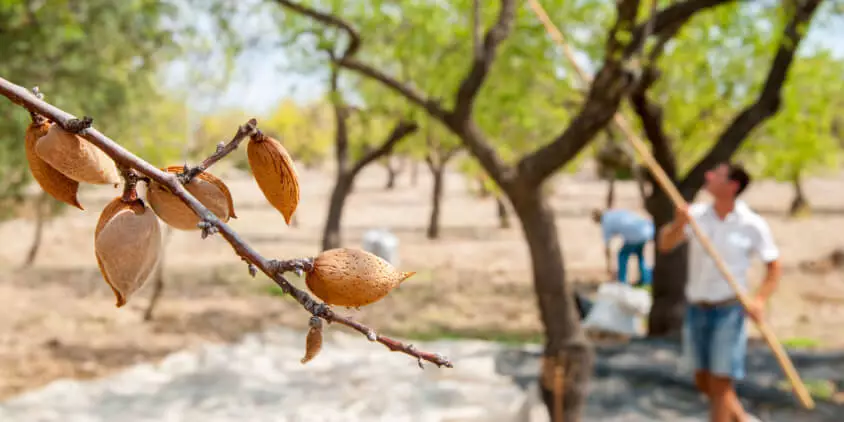
When And How To Harvest Almonds
Almond harvesting is a multi-step process that requires specialized machinery and techniques. Farmers should keep an eye on their crops’ quality throughout the almond harvesting process and reduce any negative effects it has on the local community and the environment.
When To Harvest Almonds
The almond harvest season is typically early August through late September, though this differs per variety. When the hulls of around 95% of the nuts have broken open, it’s a signal to start harvesting. The first husk split appears at the tree’s top and spreads downward. Nuts that have fallen from the tree are another sign to begin harvesting.
The almond tree’s growing time until it can produce fruits is 5–20 years.
How To Harvest Almonds
When almond harvest time arrives, machines called tree shakers go through the orchard and shake the nuts out of the trees. After 7–10 days of air drying inside their shells, the nuts are swept into neat windrows by a specialized sweeper machine. A harvester, aka a pick-up machine, then gathers the nuts by vacuuming them into a shuttle or cart.
Almost every orchard goes through this cycle two to three times because different varieties are gathered at different times. Additionally, around this time, the trees start putting together what is needed to grow next year’s crop, so farmers pay special attention to the plant’s needs during this time of year to ensure a successful future harvest.
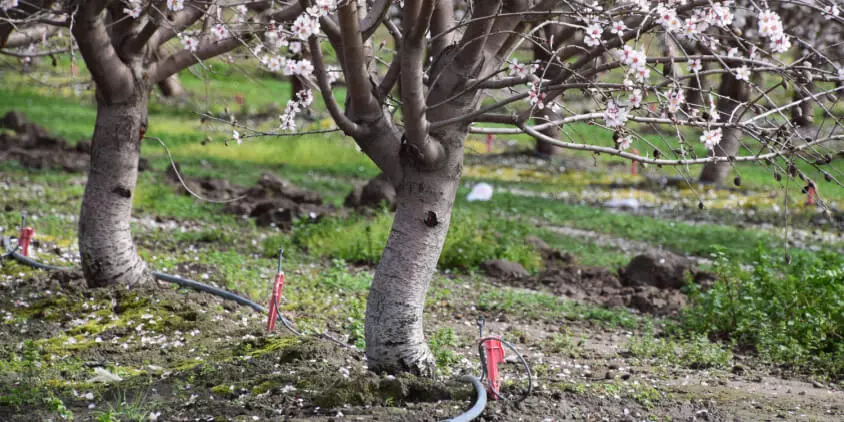
What To Do After Almond Harvesting
The work of a farmer does not stop when the crop is harvested. After all, the trees need further care so that they can produce nuts in the next growing season, and the nuts themselves must be processed and stored. Let’s take a closer look at these activities.
Post-Harvest Care Of Almond Trees
Providing nutrients and water to your trees after they have been harvested is crucial to their long-term health and increased crop yield. Post-harvest care that is both sufficient and well-balanced helps trees recover and prepare for the growing season. It fosters enhanced root growth and carbohydrate rebuilding, as well as vigorous flower formation and leaf expansion in the next growing season.
There are three essential cultural activities that farmers should perform after the harvest:
- Irrigation. Never skip the post-harvest irrigation of almonds. If you water your trees after harvest, their leaves will stay vigorous until the standard annual leaf drop (around the middle of November). By avoiding early defoliation, you give the tree enough time to move nitrogen, potassium, and phosphorus from the leaves to the fruit spurs, where they are needed for bloom and fruit formation.
- Nitrogen fertilization. It is typically advised that 20–25% of the total nitrogen budget for the almond growing season be applied after harvest. You can apply nitrogen on its own or mixed with other nutrients such as calcium, potassium, and phosphorus.
- Pruning. Once the fruits have been picked, it’s easy to tell which trees have old, sick, or dead wood. It is necessary to prune out unhealthy branches by 6–12 inches (1.5–3 cm) from where the final infected tissue is visible.
Post-Harvest Nut Processing
After being harvested, almonds arrive at a huller facility, where they are cleaned by rolling over a grate. Today’s farmers practice zero-waste agriculture by finding new uses for all leftovers, including the hulls and shells, which make for dairy feed and cattle bedding accordingly. Clean nuts are size-sorted by a sizing machine and then kept in temperature- and humidity-controlled storage until they are needed for further use.

Environmental Impact Of Growing Almonds And Sustainable Solutions For It
Is growing almonds bad for the environment? Sadly, today’s almond farming has a negative environmental impact, primarily owing to its high water use, extensive chemical application, and carbon footprint. Almond growers’ water use is often brought up as a main problem. Since the trees require a lot of water to develop, they contribute to the spread of drought in places already vulnerable to water shortages, where they typically grow.
Another major issue is the extensive use of agrochemicals. Many of them pose threats to pollinators like honey bees and wild bees. Agrochemicals promote soil erosion and the loss of fertile topsoil. Furthermore, these pollutants may leach into the soil and water, causing damage to the local ecosystems.
On top of that, almond tree growing is a contributor to greenhouse gas (GHG) emissions. California, the main producer of almonds, provides around 80% of the world’s supply. Since about 70% of their total crop must be shipped to other locations, the transportation of nuts results in significant GHG emissions .
The upside is that scientists and farming experts constantly attempt to find remedies to these issues, and some of them already have solutions. Plenty of promising techniques for the sustainable process of growing almonds have emerged in recent years:
- Precision irrigation. Farmers who use drip or micro-sprinkler systems to irrigate their growing trees save a large amount of water. Subsurface drip watering and deep root watering are even more economical and eco-friendly since they both eliminate wasteful water evaporation.
- Regenerative agriculture. This approach to growing almond trees benefits biodiversity, soil health, and water conservation by forgoing synthetic agrichemicals, growing perennial cover crops, making use of compost, and other land-regenerative practices.
- Whole Orchard Recycling (WOR). Mulching and returning dead trees to the orchard soil is another environmentally benign practice. In studies by the University of California Cooperative Extension (UCCE), WOR has been shown to increase soil organic matter, water-holding capacity, and cumulative yields .
If the industry can implement a sustainable farming model, its prospects might grow enormously. Continuously seeking to enhance and adopt sustainable approaches, we can create an almond growing sector that is beneficial to ecosystems, economies, communities, and farmers’ livelihoods.
About the author:
Vasyl Cherlinka is a Doctor of Biosciences specializing in pedology (soil science), with 30 years of experience in the field. He attended the engineering college in Ukraine and received his degree in agrochemistry, agronomy and soil science in the Chernivtsi National University. Since 2018, Dr. Cherlinka has been advising EOSDA on problems in soil science, agronomy, and agrochemistry.
Recent articles

Analyze 2025 & Plan Your Best Year Yet: LandViewer Christmas Offer
It’s the most wonderful time of the year! The Christmas holidays are here, and so is your chance to analyze 2025 and plan a prosperous 2026 with more affordable Pro plans in LandViewer.

EOSDA Models Climate Change Impact On Sugarcane Yields
EOSDA modeled future temperature, rainfall, and other climate impacts on Veracruz sugarcane. The results help growers plan long-term adaptation strategies, including timing, varieties, and irrigation.

EOSDA LandViewer Black Friday Sale: Exclusive Offers & Giveaway
This Black Friday, LandViewer offers new users the chance to save on monthly plans, get extra months with yearly subscriptions, and participate in a free annual plan giveaway.